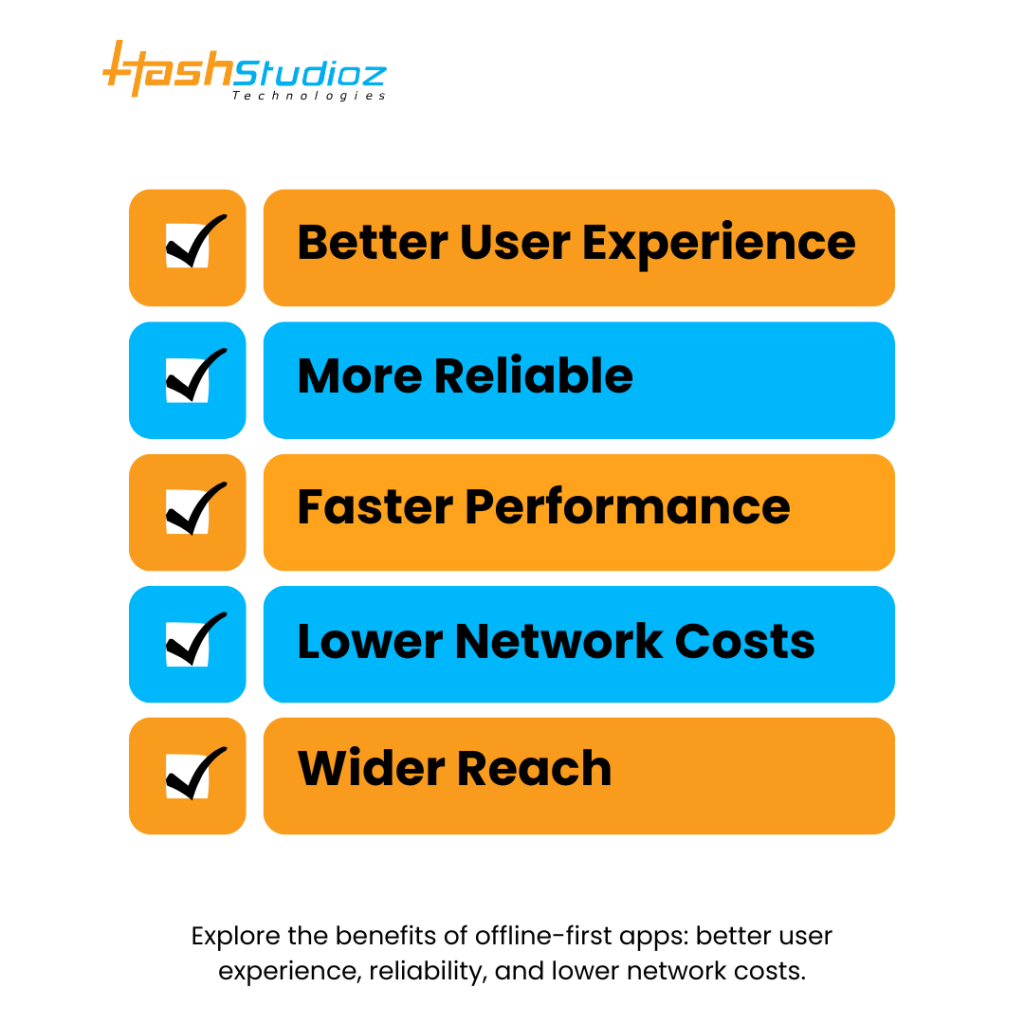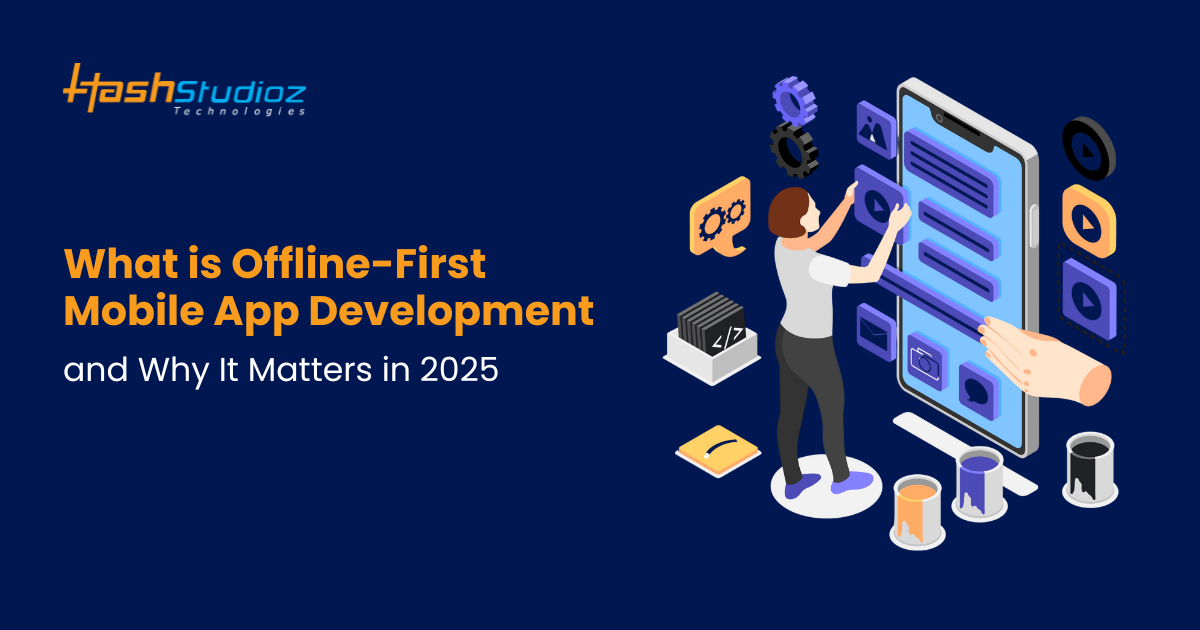The global mobile app market is rapidly expanding, expected to reach $613 billion by 2025. Despite advancements like 5G networks and AI, nearly one-third of the world’s population still faces unreliable or limited internet access. Offline-first mobile app development addresses these challenges by designing apps that remain functional without constant internet connections. This approach improves user experience, app speed, and reliability, making it essential for businesses and developers in 2025. Mobile app development companies must prioritize offline-first strategies to stay competitive and inclusive in today’s diverse connectivity landscape.
Table of Contents
- What is Offline-First Mobile App Development?
- The Need for Offline-First in 2025
- Technical Architecture of Offline-First Apps
- Benefits of Offline-First Mobile App Development
- Challenges in Offline-First Development
- Why Mobile App Development Companies Should Prioritize Offline-First in 2025
- How HashStudioz Helps You Build Powerful Offline-First Mobile Apps
- HashStudioz Mobile App Development Services Include:
- 1. Offline-First Architecture Design
- 2. Cross-Platform App Development
- 3. Progressive Web App (PWA) Development
- 4. Cloud & Real-Time Sync Integration
- 5. IoT-Integrated Mobile Apps
- 6. Robust Backend Development
- 7. UI/UX Design Optimized for Offline Use
- 8. Ongoing Maintenance & Support
- Why Choose HashStudioz?
- Conclusion
- FAQs
What is Offline-First Mobile App Development?
Offline-first mobile app development is a design approach where an app is built to perform core functions without requiring internet access. Unlike traditional online-dependent apps, offline-first apps store data locally on the device, allowing users to access features immediately.
For example, an offline-first app used in rural healthcare can keep patient records accessible and editable even without the internet. Once back online, the information syncs with central databases, maintaining data integrity. This contrasts with apps that fail or become unusable when the network drops.
The Need for Offline-First in 2025
Despite fast network technologies like 5G advancing mobile experiences, network reliability remains inconsistent globally. Statistics show 2.6 billion people still lack internet access, many living in rural or developing regions. Moreover, users frequently encounter transient issues such as tunnels, elevators, or crowded networks that disrupt connectivity.
Offline-first mobile app development solves these real-world problems by:
- Ensuring app usability even during connection interruptions or slow networks.
- Reducing frustration from waiting for server responses.
- Lowering data consumption and battery use by limiting unnecessary network calls.
- Allowing apps to load data instantly from local storage.
- Supporting users in remote fields such as agriculture, construction, and emergency services where offline access is critical.
A mobile app development company that integrates offline-first principles creates resilient apps suitable for broad audiences rather than just urban, well-connected areas.
Technical Architecture of Offline-First Apps
The offline-first model centers on the data layer. Key elements include:
- Local Data Storage: Storing app data locally using databases like SQLite, Realm, or IndexedDB enables immediate access and offline interaction.
- Synchronization Logic: Sync mechanisms detect network availability and resolve conflicts between local and server data efficiently.
- Optimized Network Requests: Updates and fetches occur only when conditions favor minimal data and battery consumption, such as during WiFi or charging.
- Queuing Offline Actions: User inputs and transactions queue locally to be processed once online.
This architecture contrasts with traditional apps that rely heavily on real-time server calls. Offline-first apps prioritize local operations, improving speed and reducing network dependency.
How DevOps Transforms Mobile App Development: Core Roles and Responsibilities
Benefits of Offline-First Mobile App Development

- Enhanced User Experience: Users appreciate apps that work on their terms without forcing them to wait for data loads.
- Increased Reliability: Offline-first apps maintain functionality during network outages, critical for industries where downtime affects productivity or safety.
- Faster Performance: Local data operations run quicker than server roundtrips, especially with data-intensive tasks.
- Reduced Network Load and Costs: By minimizing server calls, offline-first apps impose less strain on networks and reduce data usage for users.
- Broader Market Reach: Building offline capabilities makes apps viable for users in remote or underserved regions, expanding the potential customer base and fostering inclusivity.
Examples and Use Cases
- E-commerce apps with offline catalogs allow browsing and cart additions without internet; orders sync when connected.
- Note-taking and productivity apps like Microsoft OneNote historically popularized offline-first functions.
- Field service and environmental monitoring apps used in forestry or agriculture where connectivity is scarce.
- Educational apps for remote learning during outages or travel times.
- Healthcare apps for patient data management in rural clinics without steady internet.
Challenges in Offline-First Development
Developing offline-first apps requires handling data synchronization conflicts, storage limitations on devices, and complex state management. Mobile app development companies must implement mechanisms to merge offline and online changes safely. Testing also becomes more demanding to simulate different network scenarios.
Despite these challenges, the payoff in user retention and app robustness justifies the effort.
Why Mobile App Development Companies Should Prioritize Offline-First in 2025
As mobile users demand seamless experiences irrespective of connectivity, companies ignoring offline-first risk losing users to competitors. Offline-first design aligns with technical trends like 5G by complementing high-speed connectivity with resilience for when connections waver.
Furthermore, offline-first apps contribute to sustainable network usage and energy efficiency, considerations increasingly important to users and regulators.
How HashStudioz Helps You Build Powerful Offline-First Mobile Apps
HashStudioz Technologies is a leading software development company specializing in end-to-end mobile app solutions. Our team understands the unique challenges of offline-first development and delivers scalable, secure, and reliable applications tailored to your business needs.
HashStudioz Mobile App Development Services Include:
1. Offline-First Architecture Design
- Local data storage using SQLite, Realm, PouchDB, or Room
- Background sync and smart conflict resolution
- Intelligent caching strategies
2. Cross-Platform App Development
- Build high-performance apps using Flutter, React Native, or Xamarin
- One codebase, multiple platforms (iOS, Android)
3. Progressive Web App (PWA) Development
- Web apps that work offline, load instantly, and behave like native apps
- Ideal for businesses looking for cross-device reach
4. Cloud & Real-Time Sync Integration
- Integration with Firebase, AWS Amplify, Couchbase Mobile, or custom APIs
- Real-time data updates and synchronization across devices
5. IoT-Integrated Mobile Apps
- Offline-first mobile interfaces for IoT devices where real-time connectivity is limited
- Data sync once devices regain access to the cloud
6. Robust Backend Development
- Scalable APIs and cloud infrastructure to support offline-first sync and logic
- Backend optimization for data reconciliation and conflict management
7. UI/UX Design Optimized for Offline Use
- Intuitive user flows that handle network interruptions gracefully
- Custom error handling, offline indicators, and retry options
8. Ongoing Maintenance & Support
- App monitoring, performance optimization, and regular updates
- Bug fixes, feature enhancements, and real-time technical support
Why Choose HashStudioz?
- Experienced team in mobile, IoT, and cloud-native solutions.
- Global clientele across industries like logistics, healthcare, education, and fintech.
- Results-driven development with focus on performance, scalability, and security.
- Flexible engagement models from MVPs to full-scale enterprise apps.
Whether you’re building a new app or improving an existing one, HashStudioz can help you design and develop reliable, scalable offline-first mobile applications that exceed user expectations in 2025 and beyond. Let’s talk about your project today!

Conclusion
Offline-first mobile app development is a crucial strategy in 2025’s mobile ecosystem. It ensures apps perform core tasks without the internet, improving user satisfaction, speed, and reliability. With billions still facing connectivity issues, offline-first apps extend market reach and inclusivity. Mobile app development companies that embed offline-first into their core methodologies will deliver superior products that meet modern user expectations and stand resilient amid network challenges.
FAQs
1. What does offline-first mobile app development mean?
Offline-first means designing apps to work fully or partially without an internet connection by storing data locally and syncing when online.
2. Why is offline-first development important in 2025?
With growing demand for seamless user experiences and unreliable connectivity in many regions, offline-first ensures apps remain functional anytime, anywhere.
3. How does offline-first improve user experience?
It allows users to access and use app features smoothly without interruptions caused by poor or no internet.
4. Which industries benefit most from offline-first apps?
Industries like healthcare, logistics, retail, education, and finance benefit greatly, especially where connectivity is inconsistent.
5. How can companies implement offline-first mobile apps?
By leveraging technologies like local databases, background syncing, and frameworks supporting offline capabilities, often with help from experienced developers like HashStudioz.

